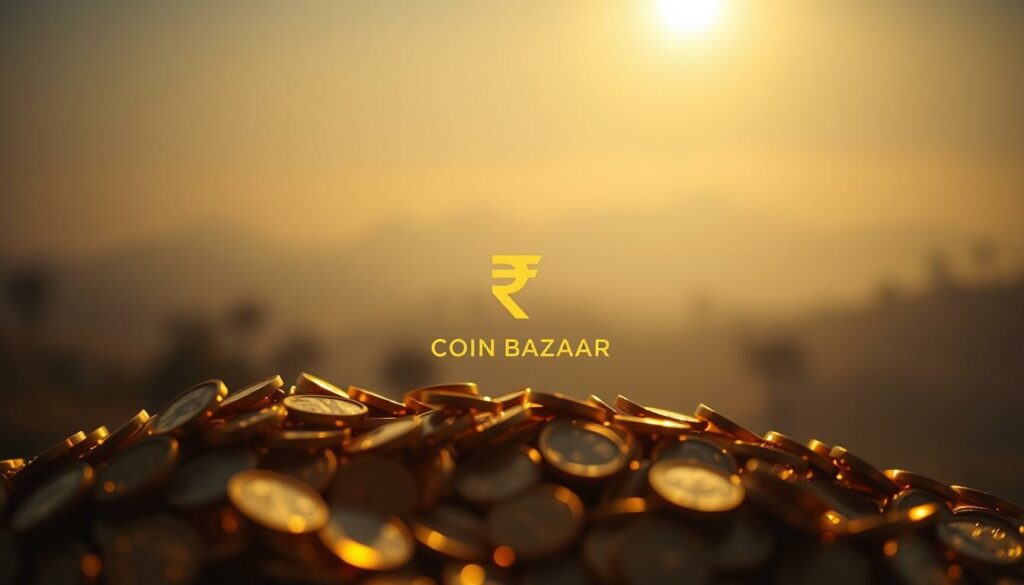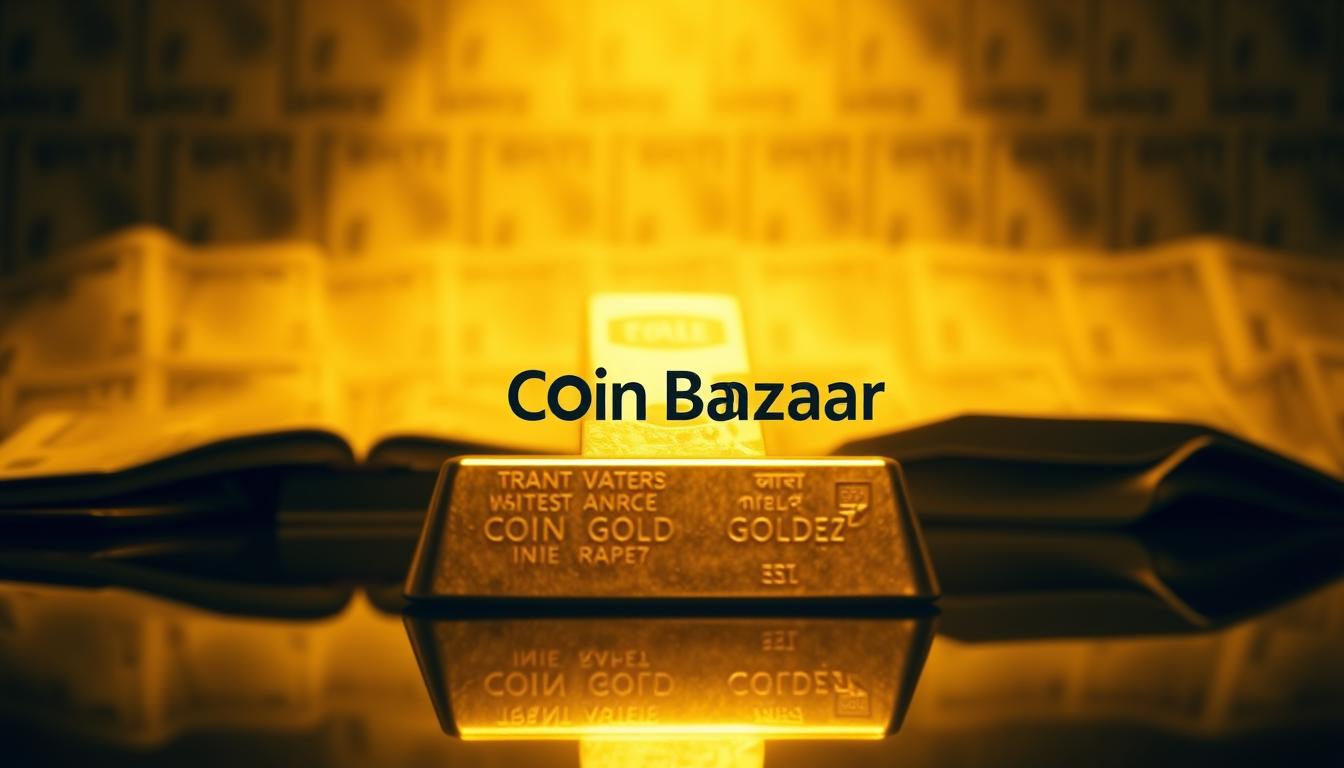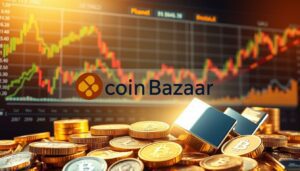Exclusive Deals & Trending Items
You might know about safe haven assets. These are investments that feel secure when the economy is shaky. Precious metals are often a key part of many portfolios.
When things get tough, people often choose gold to safeguard their money. It’s known for keeping its value, making it a smart choice for the long haul. Adding gold to your mix can help make your investments more stable and less risky.
Thinking about your 2025 investment plans? It’s crucial to see how gold fits into your strategy.
Key Takeaways
- Gold has historically performed well during economic uncertainty.
- Including gold in a portfolio can reduce risk and increase stability.
- A well-diversified portfolio can help investors achieve their long-term goals.
- Gold is a strategic long-term investment option.
- It’s essential to consider gold when planning your investments for 2025.
The Enduring Appeal of Gold Throughout History
Gold has always been more than just a metal. It’s been a store of value, a symbol of power, and a cultural icon. Its appeal has lasted for centuries, making it a special asset class.
Gold’s Historical Role in Global Finance
Gold has been key in global finance. It has been a standard for currencies and a reserve for central banks. Its importance is clear in backing currencies and as a hedge against economic uncertainty.
| Year | Event | Gold’s Role |
|---|---|---|
| 1879 | Adoption of Gold Standard | Backing currencies |
| 1944 | Bretton Woods System | Reserve asset |
| 1971 | Nixon Shock | Shift from gold standard |


Cultural Significance of Gold in India
In India, gold is more than a valuable commodity. It’s a key part of the culture. It’s seen as a symbol of prosperity and good fortune.
Traditional Gold Ownership in Indian Households
Gold ownership is a tradition in many Indian homes. It’s seen as a safe haven investment. Families buy gold during special occasions, not just for investment but to keep wealth.
Gold in Indian Festivals and Celebrations
Gold is important in Indian festivals and celebrations. It’s common to give gold jewelry at weddings and other big events. This shows its cultural value and the benefits of investing in gold as a long-term asset.
The cultural importance of gold in India is closely linked to its economic value. It serves both practical and symbolic purposes.
What Makes an Asset a “Safe Haven”?
Investors often look for safe haven assets to protect their wealth when markets are volatile. In times of economic uncertainty, some assets perform better than others. This attracts investors seeking a safe place to put their money.
Defining Safe Haven Assets
Safe haven assets keep or grow in value during market ups and downs. They usually don’t move with other assets, making them good for spreading out investments. Gold is a top example because it has done well during economic crises.
Key Characteristics of Safe Haven Investments
Safe haven investments have traits that make them appealing in uncertain times. Two important ones stand out:
Value Retention During Market Turbulence
These assets keep their value or even go up when others fall. For example, gold prices often surge during economic downturns as investors seek safe havens.
Liquidity and Universal Acceptance
Liquidity is another key trait. Safe haven assets are easy to buy and sell without big price changes. Gold, for instance, is widely accepted and can be quickly turned into cash.


| Characteristic | Description | Example |
|---|---|---|
| Value Retention | Holding value during market downturns | Gold prices rising during economic crises |
| Liquidity | Ease of buying and selling without affecting price | Gold being easily convertible to cash |
| Universal Acceptance | Widely recognized and accepted across markets | Gold being a globally accepted store of value |
Knowing these traits helps you decide if adding safe haven assets like gold to your portfolio is smart. This is especially true when thinking about gold as a hedge against inflation in your long-term plans.
Gold as a Safe Haven Asset: Traditional Perspectives
Gold’s appeal as a safe asset is timeless. It’s valued for its real worth and past success. You might ask why gold is a favorite for those looking for safety. The answer is in its special qualities and its role in tough economic times.
Gold’s Intrinsic Value Proposition
Gold’s worth comes from itself, not from governments or companies. This inherent value is why people choose gold when things get uncertain. Unlike paper money, gold’s value doesn’t fall with inflation or get devalued.
Adding gold to your investment mix can protect against market ups and downs. Here’s why:
- Gold is widely seen as a safe value keeper.
- It doesn’t move with other investments, making it a smart mix.
- Gold is easy to sell, giving quick access to cash when needed.
Historical Performance During Economic Crises
Gold has consistently done well when the economy is bad. Let’s look at its performance in two big crises: the 2008 financial crisis and the COVID-19 pandemic.
Gold During the 2008 Financial Crisis
In 2008, gold prices soared as investors sought safe places to put their money. The price of gold jumped from about $800 per ounce at the start of 2008 to over $1,900 per ounce by 2011’s end. This rise was because people lost faith in the financial world and looked for safety.
Gold’s Response to the COVID-19 Pandemic
The COVID-19 pandemic also saw gold prices hit new highs. As governments took on huge debts and eased money policies, investors turned to gold to safeguard their wealth. Gold took on demand as investors sought something better than bonds, due to the large amount of bonds issued and losses from government borrowing and inflation.
In summary, gold’s real value and past success make a strong case for investing in it. Its role as a safe haven during economic troubles shows its importance in 2025 and beyond.
The Global Economic Landscape in 2025
The global economy in 2025 is a mix of recovery and uncertainty. This affects gold prices. Economies are still adjusting to life after the pandemic, with different speeds of recovery.
Post-Pandemic Economic Recovery Patterns
The recovery after the pandemic is not even. Some places are growing fast, while others face inflation and supply chain issues. This uneven pace affects gold demand and prices.
Key recovery patterns include:
- Robust growth in technology and service sectors
- Increased government spending on infrastructure
- Shifts in consumer behavior towards savings
These factors make the environment for gold as a safe-haven asset complex.
Geopolitical Tensions and Their Impact on Markets
Geopolitical tensions are big players in 2025’s market dynamics. These tensions affect trade policies and global supply chains. This impacts investor mood and asset prices.
US-China Relations and Trade Policies
The US-China relationship is key to global economic stability. Tensions between them can cause market swings, affecting gold prices.
Emerging Market Dynamics
Emerging markets are important in the global economy. Their growth and responses to global trends can influence gold demand, especially in India.
Gold’s performance shows a growing distrust in traditional safe-haven assets like U.S. Treasuries. These have seen big losses due to high government borrowing and inflation. Here’s a table of key factors affecting gold prices in 2025:
| Factor | Impact on Gold Prices | Current Trend |
|---|---|---|
| Post-Pandemic Recovery | Increased demand for safe-haven assets | Uneven recovery across regions |
| Geopolitical Tensions | Higher prices due to increased uncertainty | Escalating tensions in key regions |
| Inflation Concerns | Gold as a hedge against inflation | Persistent inflation in many economies |
Gold Market Performance: 2020-2025 Analysis
The years 2020 to 2025 have seen gold prices soar over 27% year-to-date. This outpaces all major asset classes, drawing comparisons to crisis-era hedging. Several factors have driven gold’s impressive rise.
Price Trends and Volatility Assessment
Gold prices have risen steadily from 2020 to 2025, with some volatile periods. Global economic conditions, geopolitical tensions, and investor sentiment have shaped this volatility. The average annual volatility of gold prices has been about 15%, slightly higher than before.
Gold remains a safe-haven asset, attracting investors during economic uncertainties. Its price has surged during geopolitical stress and economic downturns. This highlights its role as a reliable store of value.
Key Drivers of Gold Prices in Recent Years
Several factors have influenced gold prices from 2020 to 2025. Understanding these can help with investment decisions.
Central Bank Policies and Gold Reserves
Central banks have significantly impacted gold prices through their reserve management. Many central banks have bought gold, increasing their reserves and supporting prices. This trend is likely to continue as central banks diversify their assets and reduce risks from fiat currencies.
Supply Chain Disruptions and Mining Output
Supply chain disruptions and mining output changes have also affected gold prices. The COVID-19 pandemic caused operational challenges in gold mining, leading to reduced output and higher prices. As mining operations adjust, the supply side is expected to stabilize, possibly influencing gold prices in the future.
Gold as a Hedge Against Inflation in 2025
The year 2025 is a test for gold as an inflation hedge. As the economy changes, knowing how gold works is key for investors.
Current Inflation Scenarios Worldwide
Inflation rates differ around the world. It’s important to know these trends to see how gold helps.
Inflation Trends in Developed Economies
Developed countries face different inflation levels. Some see inflation rise after the pandemic, while others keep rates low.
In the U.S., inflation rates change due to money policy and global issues. The European Union struggles to keep inflation steady among its countries.
The Indian Inflation Outlook
India’s inflation is shaped by farm output, global prices, and demand. By 2025, India’s inflation is moderate, with the Reserve Bank of India working to keep prices stable.
India’s inflation outlook is hopeful, with a stable rate expected soon. This is thanks to smart money policy and government actions.
Gold’s Effectiveness Against Modern Inflation Patterns
Gold is often seen as a good inflation hedge. But its success depends on the type of inflation and the world economy.
When inflation comes from too much money and currency value drops, gold does well. This is because gold’s value isn’t linked to any currency or government policy.
| Inflation Scenario | Gold’s Performance | Investor Behavior |
|---|---|---|
| Moderate Inflation | Stable to Positive | Investors seek gold as a hedge |
| High Inflation | Positive | Increased demand for gold |
| Low Inflation | Variable | Gold less attractive, but still considered for diversification |
Gold benefits in all scenarios: easing policy makes gold more appealing, and delayed action keeps gold as a hedge.
For investors, it’s vital to grasp these points. This knowledge helps in deciding how much gold to include in their portfolios.
Digital Gold vs. Physical Gold: What’s Better in 2025?
Gold prices are expected to hit $3,700 per ounce by 2025, says Goldman Sachs. This makes choosing between digital and physical gold more important than ever. Knowing the differences between these two gold types is key to a smart investment choice.
The Rise of Digital Gold Investment Options
Digital gold is becoming a popular choice over traditional physical gold. It offers ease and flexibility. Now, you can invest in gold through digital platforms, making it simpler to buy, sell, and hold.
Gold ETFs and Mutual Funds in India
In India, Gold ETFs and mutual funds are gaining fans. They let you invest in gold without needing to store it physically. These options are backed by real gold and help diversify your portfolio.
Sovereign Gold Bonds and Their Benefits
Sovereign Gold Bonds (SGBs) are a digital gold investment with extra perks. They offer regular interest and tax benefits. Issued by the government, SGBs are a great choice for gold investors.
Benefits and Drawbacks of Physical Gold Ownership
Physical gold has its own pluses and minuses. You must think about storage, security, and how easy it is to sell. These factors are important when investing in physical gold.
Gold Jewelry as Investment in Indian Context
In India, gold jewelry is seen as both a fashion statement and an investment. But, the cost of making it and its gold purity can affect its value as an investment.
Gold Coins and Bars: Purity and Certification
Investing in gold coins and bars means checking their purity and certification. Make sure your gold is hallmarked and certified by trusted agencies to avoid problems.
Choosing between digital and physical gold depends on your investment goals and preferences. Understanding the pros and cons of each helps you make a choice that fits your financial plan.
Gold vs. Alternative Safe Haven Assets
When times are uncertain, it’s key to look at gold and other safe assets. The world of investments is wide, with many options to protect your wealth when the economy is down.
Cryptocurrencies as Competing Safe Havens
Cryptocurrencies, like Bitcoin, are seen as safe assets. They offer a new way to invest, separate from traditional options. But, they are much more volatile than gold. This makes them riskier for those who prefer safer investments.
Key characteristics of cryptocurrencies as safe havens:
- Decentralized and independent of central banks
- High volatility
- Limited adoption as a medium of exchange
Real Estate and Government Bonds Comparison
Real estate and government bonds are also safe assets. Real estate can earn rental income and grow in value over time. But, it’s not easy to sell and can be affected by market changes. Government bonds offer steady returns with little risk, but their value can change with interest rates.
Comparison of gold, real estate, and government bonds:
| Asset | Liquidity | Return Potential | Risk Level |
|---|---|---|---|
| Gold | High | Medium | Low-Medium |
| Real Estate | Low | High | Medium-High |
| Government Bonds | High | Low-Medium | Low |
Diversification Strategies Using Multiple Safe Havens
Spreading your investments across different safe assets can reduce risk. Mixing gold, government bonds, and other safe havens can make your portfolio more stable. This way, you’re better prepared for economic ups and downs.
Optimal Portfolio Allocation Models
A good mix might be 40% gold, 30% government bonds, and 30% other safe assets. But, the right mix depends on your risk level, goals, and the market.
Rebalancing Strategies During Market Volatility
It’s important to rebalance your portfolio when markets are shaky. Regular checks and adjustments help keep your investments in line with your goals and risk comfort.
Gold has done well over the last 20 years, beating the S&P 500 with a 620% return. This shows gold’s value as a safe investment. By diversifying and using different safe assets, you can make your investments more resilient in uncertain times.
The Indian Perspective: Gold Investment in 2025
Gold prices have hit a record high, and India’s market is buzzing. As an investor, you might wonder how gold fits into your 2025 strategy.
Gold’s Role in Indian Investment Portfolios
In India, gold is a top choice for investors. It’s valued for its potential gains and cultural importance. Gold is especially important in portfolios during economic shaky times.
Urban vs. Rural Gold Investment Patterns
Gold investment habits differ in urban and rural India. City folks prefer digital gold and ETFs. Meanwhile, rural areas favor physical gold. Knowing these trends helps in making smart gold investment choices.
Gold as Retirement Planning Tool
Gold is becoming a key part of retirement plans. It can protect against inflation and market ups and downs. Investing in gold for retirement helps keep value and offers a safe haven during tough times.
Regulatory Environment and Tax Implications
When investing in gold in India, the rules and taxes matter a lot. Knowing the tax laws and regulations helps maximize your returns.
GST and Import Duties on Gold
The GST and import duties on gold affect your investment. For example, a higher GST rate can raise the cost of gold. These costs should be considered in your investment plans.
Capital Gains Tax Considerations
Capital gains tax on gold is another key factor. It’s important to understand how this tax applies to your gold, whether digital or physical. This helps minimize your tax burden.
As you explore the Indian gold market in 2025, staying updated on trends, rules, and taxes is crucial. This knowledge helps optimize your gold investments and reach your financial targets.
Practical Strategies for Gold Investment in 2025
Gold fund inflows have reached $80 billion this year. This shows investors still like gold. When thinking about gold in your 2025 portfolio, knowing the best ways to invest is key.
Optimal Allocation Percentages for Different Investor Profiles
How much gold to put in your portfolio depends on who you are. Advisors suggest 5% to 15% of your portfolio for gold.
Conservative vs. Aggressive Portfolio Allocations
Conservative investors might choose 5-7% gold to protect against market ups and downs. Aggressive investors might go for 10-15% to aim for bigger gains when the economy is slow.
Age-Based Gold Investment Recommendations
- Younger Investors (20-40 years): Start with 5-7% gold to handle market changes over time.
- Middle-Aged Investors (40-60 years): Aim for 7-10% gold to balance risk and reward.
- Retirees (60+ years): Consider 10-15% gold to protect savings from inflation and market swings.
Timing Your Gold Investments: Signs to Watch For
Timing is everything in gold investments. Look for signs like economic trouble, rising inflation, and global tensions.
Technical Indicators for Gold Markets
Tools like the Relative Strength Index (RSI) and Moving Averages can guide when to buy or sell gold.
Seasonal Patterns in Gold Prices
Gold prices often rise in certain months due to cultural demand or global events.
By grasping these strategies and keeping up with gold price trends and gold market analysis, you can make better gold investment choices in 2025.
Risks and Challenges for Gold Investors
Gold is often viewed as a safe haven investment. Yet, it comes with its own set of challenges. Understanding these risks is key to making smart investment choices.
Market Manipulation and Volatility Concerns
The gold market faces issues like manipulation and volatility. It’s important for investors to grasp these dynamics.
Understanding Gold Price Fixing Mechanisms
Gold prices are shaped by various factors, including price fixing mechanisms. The London Gold Fixing, now known as the London Bullion Market Association (LBMA) Gold Price, has been crucial. However, these mechanisms can sometimes be manipulated.
Identifying Market Manipulation Signals
To tackle these risks, keep an eye out for signs of manipulation. Look for unusual price movements or trading volumes. Staying updated with market news and analysis can help spot potential manipulation.
Storage, Insurance, and Liquidity Issues
Investors in physical gold face challenges related to storage, insurance, and liquidity.
Secure Storage Options in India
In India, you can choose from several secure storage options for physical gold. Bank lockers and specialized vaults are available. It’s important to pick a storage method that balances security with ease of access.
Insurance Policies for Physical Gold
Insuring your physical gold is crucial. Look for policies that cover theft, loss, and damage. It’s vital to understand the terms and conditions of these policies to ensure proper protection.
By understanding these challenges and taking steps to address them, you can effectively use gold as a hedge against inflation and market volatility.
Expert Predictions: The Future of Gold Beyond 2025
The gold market is set for changes beyond 2025, thanks to expert forecasts and new trends. Investors need to understand these predictions to make smart choices about gold.
Analyst Forecasts and Market Sentiment
Experts are making big calls on gold prices. Goldman Sachs thinks gold could hit $4,500 an ounce in a high-risk scenario. This would be a 71.5% jump. These predictions are based on the economy, world events, and market trends. Investors should watch these forecasts closely as they can change how people feel about gold and its price.
Emerging Trends That Could Reshape Gold’s Status
New trends could change how we see gold in investments. Two key areas to watch are tech improvements in mining and refining, and what people want in gold products.
Technology Impacts on Gold Mining and Refining
New tech is changing gold mining and refining. Improved extraction methods and better refining can increase supply. This could affect gold prices. Also, tech makes mining greener, appealing to investors and buyers.
Changing Consumer Preferences in Gold Products
People are now looking for gold that’s good for the planet and fair to miners. This shift is because of growing concerns about gold mining’s impact. Jewelry makers and investors are looking for gold that’s certified as eco-friendly.
Conclusion: Is Gold Still a Relevant Safe Haven in 2025?
Gold is telling a familiar story in today’s financial world. It’s one of fear, flight, and financial stress. Gold has always been a reliable safe haven, and it’s still important in 2025. The gold market analysis shows that gold is key for a well-rounded investment portfolio.
Gold’s value and past performance during tough times make it appealing to investors. It’s a good choice for those looking to protect their money. With ongoing global tensions and inflation worries, gold’s role as a safe haven is likely to stay strong.
In short, gold is still a vital safe haven asset in 2025. Its ability to protect against financial stress and its long history make it a great addition to any investment plan. When thinking about your investments, don’t overlook gold.





















2 Responses
Gold’s stability during uncertain times is well-known, but I’m curious about how geopolitical factors might influence its future value. With global tensions on the rise, could these external factors become a more significant influence on gold prices?
Given the unpredictability of markets these days, it’s no surprise that gold remains a safe haven for many investors. Do you think other metals like silver are gaining similar traction in 2025?